About
Visit
Museum
Photos
Video
News
Events
Roof and Building Improvement Project - click on Announcements
Dec. 4 - Capitol Cafe open late 5-8 pm
Dec. 4 - Shop open until 7:30 pm



STATEHOUSE NEWS

Dozens of plein-air artists will converge on Capitol Square from 10 a.m. to 3 p.m. Friday, June 14. Artists throughout Ohio will "choose a spot" on Capitol Square and paint in the tradition of plein air. En plein air is a French expression which means "in the open air," and is particularly used to describe the act of painting outdoors.
Visitors are invited to engage with artists from Central Ohio Plein Air as they create their works of art. The event is free and open to the public.
Artwork created during this day will be placed on exhibit in the Ohio Statehouse Map Room, located on the ground floor. The exhibition will be on view from July 3 to July 30. Most artwork will be available for purchase through the Statehouse Museum Shop.
The Statehouse Museum Shop, located on the ground floor of the Statehouse, will host an Ohio Proud food tasting in conjunction with the plein-air event from 10 a.m. to 3 p.m. Friday, June, 14. The public is invited to stop by the gift shop and try a number of fantastic Ohio foods.
In case of inclement weather, the plein-air event will be rescheduled.
For more information about Central Ohio Plein Air, visit www.centralohiopleinair.com.
To view this press release and others, visit www.ohiostatehouse.org.
The Ohio Statehouse is more than a monument to our past; it's where history happens! The Ohio Statehouse is open weekdays from 7 a.m. to 6 p.m.; weekends from 11 a.m. to 5 p.m.; closed holidays. The Ohio Statehouse Museum is open weekdays from 9 a.m. to 5 p.m.; weekends from noon to 4 p.m.; closed holidays. Admission is free. Free guided tours are offered weekdays on the hour from 10 a.m. to 3 p.m., and weekends from noon to 3 p.m. Tours depart from the Map Room easily accessible from the Third Street entrance. Groups of 10 or more are requested to call in advance to ensure a guide is available. Contact 888/OHIO-123 for more information or to schedule a group tour. For more information about the Ohio Statehouse visit www.ohiostatehouse.org.
The Ohio Statehouse is handicapped accessible and senior friendly. The Capitol Square complex was restored to allow for greater access by individuals living with disabilities. Ohio Statehouse public programs and events are held in accessible and barrier free areas of the building so that everyone can participate. Ohio Statehouse visitors needing disability-related accommodations in order to fully participate in an event may contact the Capitol Square Review and Advisory Board at statehouse@csrab.state.oh.us or 614/752-9777 to communicate special needs. Please allow three weeks for arrangements to be completed.
The Capitol Square Review and Advisory Board (CSRAB) is responsible for maintaining the historic character of the Statehouse and Capitol Square while providing for the health, safety and convenience of those who work in or visit the complex. The Ohio Statehouse Museum Education Center coordinates tours of Capitol Square and provides information about the buildings, their history and Ohio's government.
# # #
The Capitol Square Review and Advisory Board (CSRAB) is proud to announce that the Ohio Statehouse has been nominated by Columbus Parent Magazine, for their "Best of Columbus" contest, in three categories. The Ohio Statehouse was nominated in the following categories:
- Best Place to Bring Out-of-Town Visitors
- Best Museum
- Best Locally Made Gifts
"The unique ability to house state government, while at the same time offer innovative public programs, is what makes the Ohio Statehouse unlike any other capitol in the country," said William E. Carleton, Executive Director of the Capitol Square Review and Advisory Board.
To see the entire list of nominees and to vote, please, visit www.columbusparent.com/bestofcolumbus.
To view this press release and others, visit www.ohiostatehouse.org.
The Ohio Statehouse is more than a monument to our past; it's where history happens! The Ohio Statehouse is open weekdays from 7 a.m. to 6 p.m.; weekends from 11 a.m. to 5 p.m.; closed holidays. The Ohio Statehouse Museum is open weekdays from 9 a.m. to 5 p.m.; weekends from noon to 4 p.m.; closed holidays. Admission is free. Free guided tours are offered weekdays on the hour from 10 a.m. to 3 p.m., and weekends from noon to 3 p.m. Tours depart from the Map Room easily accessible from the Third Street entrance. Groups of 10 or more are requested to call in advance to ensure a guide is available. Contact 888/OHIO-123 for more information or to schedule a group tour. For more information about the Ohio Statehouse visit www.ohiostatehouse.org.
The Ohio Statehouse is handicapped accessible and senior friendly. The Capitol Square complex was restored to allow for greater access by individuals living with disabilities. Ohio Statehouse public programs and events are held in accessible and barrier free areas of the building so that everyone can participate. Ohio Statehouse visitors needing disability-related accommodations in order to fully participate in an event may contact the Capitol Square Review and Advisory Board at statehouse@csrab.state.oh.us or 614/752-9777 to communicate special needs. Please allow three weeks for arrangements to be completed.
The Capitol Square Review and Advisory Board (CSRAB) is responsible for maintaining the historic character of the Statehouse and Capitol Square while providing for the health, safety and convenience of those who work in or visit the complex. The Ohio Statehouse Museum Education Center coordinates tours of Capitol Square and provides information about the buildings, their history and Ohio's government.
# # #
The Capitol Square Review and Advisory Board (CSRAB) Space/Holocaust Committee will meet Wednesday, June 5, 2013 at the Ohio Statehouse, 1 Capitol Square, Columbus. The committee will meet in Room 216 of the Ohio Statehouse at 10 a.m. to review the artist recommendation provided by The Holocaust Memorial Artist Selection Committee.
To view this press release and others, visit www.ohiostatehouse.org.
# # #
The Capitol Square Review and Advisory Board (CSRAB) today announced the acceptance of a $2,000 grant from The Little Garden Club of Columbus. The grant will be used to purchase flowers to be planted on Veterans Plaza and the Statehouse grounds. The flower pattern will form the American and Ohio flags. Funds will also purchase annuals that will form quilt patterns on the north and south side of Capitol Square. This year’s Quilt patterns are “Turn and Dash” in the Broad Street planter and “Grandmothers Fan” in the State Street planter.
“We are extremely grateful to the Little Garden Club of Columbus for their generous donation. The Club’s support enhances the Statehouse grounds for all Ohioans to enjoy – CSRAB is proud of our partnership that continues to bear beautiful fruit,” said William E. Carleton, Executive Director of the Capitol Square Review and Advisory Board.
The Little Garden Club of Columbus’ commitment to Capitol Square will ensure that the Ohio Statehouse continues to be a symbol of elegance and grandeur for the people of Ohio. The Ohio Statehouse grounds serves as a prominent green oasis in the heart of the capital city. More than 100 plant species are maintained on the grounds; including a variety of trees, shrubs, perennials and annuals.
Situated on 10 acres in the heart of downtown Columbus, with the backdrop of the magnificent Greek Revival Capitol building, the Ohio Statehouse grounds encompass expansive pastoral green spaces, flower gardens and sculpture honoring Ohio’s past. The grounds continue to serve as a gathering place for both historic rallies and everyday events.
Images are available upon request.
To view this press release and others, visit www.ohiostatehouse.org.
The Ohio Statehouse is more than a monument to our past; it's where history happens! The Ohio Statehouse is open weekdays from 7 a.m. to 6 p.m.; weekends from 11 a.m. to 5 p.m.; closed holidays. The Ohio Statehouse Museum is open weekdays from 9 a.m. to 5 p.m.; weekends from noon to 4 p.m.; closed holidays. Admission is free. Free guided tours are offered weekdays on the hour from 10 a.m. to 3 p.m., and weekends from noon to 3 p.m. Tours depart from the Map Room easily accessible from the Third Street entrance. Groups of 10 or more are requested to call in advance to ensure a guide is available. Contact 888/OHIO-123 for more information or to schedule a group tour. For more information about the Ohio Statehouse visit www.ohiostatehouse.org.
The Ohio Statehouse is handicapped accessible and senior friendly. The Capitol Square complex was restored to allow for greater access by individuals living with disabilities. Ohio Statehouse public programs and events are held in accessible and barrier free areas of the building so that everyone can participate. Ohio Statehouse visitors needing disability-related accommodations in order to fully participate in an event may contact the Capitol Square Review and Advisory Board at statehouse@csrab.state.oh.us or 614/752-9777 to communicate special needs. Please allow three weeks for arrangements to be completed.
The Capitol Square Review and Advisory Board (CSRAB) is responsible for maintaining the historic character of the Statehouse and Capitol Square while providing for the health, safety and convenience of those who work in or visit the complex. The Ohio Statehouse Museum Education Center coordinates tours of Capitol Square and provides information about the buildings, their history and Ohio's government.
# # #
The Ohio Statehouse today announced the 2013 Summer Fridays at the Statehouse schedule of performances. The Capitol Square Review and Advisory Board (CSRAB) has partnered with 13 central Ohio performing arts groups to present, Summer Fridays at the Statehouse. Summer Fridays is a FREE lunch-time outdoor performing arts series staged on the West Plaza (High Street) of the historic Ohio Statehouse. Summer Fridays at the Statehouse provides an opportunity for the public and downtown community to gather on Capitol Square to experience some of Columbus’ diverse arts groups and to visit the beautiful Capitol building.
This year’s participating performing arts groups include a diverse cross section of central Ohio’s arts organizations.
Scheduled 2013 performances include:
May 31 – Opera Columbus, concert performance of La Bohème
June 7 – One Way Gospel Singers, Gospel & Country
June 14 – (Flag Day) RMT Presents, Songs of America, Americana
June 21 – Franklin Xpress, Classic Rock
June 28 – Columbus Gay Men’s Chorus, Choral
July 5 – NO CONCERT
July 12 – Ohio Dance
July 19 – Columbus Symphony Youth Orchestra Pops, Classical
July 26 – Alliance of Greater Central Ohio, Barbershop Harmony
August 2 – Ladies of Longford, Celtic
August 9 – Grassahol Band, Bluegrass
August 16 – Big Iron, Country, Bluegrass, Gospel
August 23 – The Smoking Guns, Blues, Country, Rock
August 30 – Steve Ball, Music of the Civil War
Summer Fridays at the Statehouse will take place Fridays, May 31 through August 30 (absent July 5). The program will run between noon and 1 p.m. The series gives the downtown community and visitors the opportunity to enjoy the majestic Statehouse grounds while some of Columbus’ best arts groups perform. There is no better place, downtown, to enjoy your lunch this summer!
Visitors are encouraged to bring their lunch – there are a number of downtown restaurants located on Capitol Square. Also, CSRAB will be taking non-perishable food donations for Operation Feed through June 14.
Performances will be canceled in the event of inclement weather. Up to the minute performance information about Summer Fridays at the Statehouse will be posted on the front page of the Ohio Statehouse website at www.ohiostatehouse.org. Summer Fridays at the Statehouse audience members are encouraged to visit the Statehouse website each morning of the scheduled performances to retrieve last minute performance information.
Media support for Summer Fridays at the Statehouse is provided by 10 TV and CD 101.
High resolution photos from the 2012 season are available at: http://www.ohiostatehouse.org/Multimedia/MediaLibrary/Collection.aspx?start=1&collectionId=108519
A 30 second Public Service Announcement promoting the event can be viewed at:
http://www.ohiostatehouse.org/Multimedia/MediaLibrary/Media.aspx?fileId=138816
Facts About Downtown Columbus
• Approximately 100,000 employees work downtown
• Home to thousands of residents
• Downtown Columbus is one of the safest places in central Ohio
• 30,000 students attend classes at one of four downtown colleges or universities
• Downtown has accessible public transportation service; COTA bus stops located near the Ohio Statehouse
To view this press release and others, visit www.ohiostatehouse.org.
The Ohio Statehouse is more than a monument to our past; it's where history happens! The Ohio Statehouse is open weekdays from 7 a.m. to 6 p.m.; weekends from 11 a.m. to 5 p.m.; closed holidays. The Ohio Statehouse Museum is open weekdays from 9 a.m. to 5 p.m.; weekends from noon to 4 p.m.; closed holidays. Admission is free. Free guided tours are offered weekdays on the hour from 10 a.m. to 3 p.m., and weekends from noon to 3 p.m. Tours depart from the Map Room easily accessible from the Third Street entrance. Groups of 10 or more are requested to call in advance to ensure a guide is available. Contact 888/OHIO-123 for more information or to schedule a group tour. For more information about the Ohio Statehouse visit www.ohiostatehouse.org.
The Ohio Statehouse is handicapped accessible and senior friendly. The Capitol Square complex was restored to allow for greater access by individuals living with disabilities. Ohio Statehouse public programs and events are held in accessible and barrier free areas of the building so that everyone can participate. Ohio Statehouse visitors needing disability-related accommodations in order to fully participate in an event may contact the Capitol Square Review and Advisory Board at statehouse@csrab.state.oh.us or 614/752-9777 to communicate special needs. Please allow three weeks for arrangements to be completed.
The Capitol Square Review and Advisory Board (CSRAB) is responsible for maintaining the historic character of the Statehouse and Capitol Square while providing for the health, safety and convenience of those who work in or visit the complex. The Ohio Statehouse Museum Education Center coordinates tours of Capitol Square and provides information about the buildings, their history and Ohio's government.
# # #
CALENDAR LISTING:
Summer Fridays at the Statehouse Lunch-Time Performing Arts Series
Each Friday from May 31 - August 30, 2013 (absent July 5); 12 p.m. - 1:00 p.m.
Ohio Statehouse West Steps and Plaza, 1 Capitol Square; downtown Columbus
www.ohiostatehouse.org
614/752-9777
Free!
Enjoy a free lunch-time concert on the West Plaza of the Ohio Statehouse each Friday from May 31 through August 30 (absent July 5). View the concert schedule at www.ohiostatehouse.org.
Canceled in the event of rain.
A two-day Civil War encampment will take place on the Statehouse lawn; May 10 and 11. The 1st Ohio Light Artillery, Battery A Civil War re-enacting group will offer living history lessons during an 1860s-era encampment of Union Army Troops on the West lawn of the Ohio Statehouse both days from 9 a.m. until 3 p.m. This event is free and open to the public.
The event will recreate camp life in the field during the American Civil War, which began more than 150 years ago in 1861. Union Army Troops used the Ohio Statehouse grounds and interior as they awaited their orders to depart for combat between 1861 and 1865 during the American Civil War.
The Ohio Statehouse Civil War Encampment is designed to educate visitors about Ohio’s role in the Civil War and foster interest in the study of Ohio and American history through living history experiences. Encampment activities will include interactive talks, demonstrations and re-enactments of camp and civilian life in mid-19th century America. Civil War cannon firing demonstrations are scheduled to take place each half-hour between 9 a.m. and 3 p.m., and more frequently during the lunch hour, both days.
The demonstration is designed to highlight history during the Civil War and involves the safe use of one of the four original Civil War cannons that reside on Statehouse grounds.
There will be activities for children. Visitors of all ages may observe or join in games such as hoops and graces, tug-of-war, jump rope, croquet and other traditional leisure activities often pursued during the American Civil War.
In the event of inclement weather, the encampment will be moved indoors to the Statehouse Rotunda, Atrium and Museum Gallery.
High resolution images are available at http://www.ohiostatehouse.org/Multimedia/MediaLibrary/Collection.aspx?start=1&collectionId=108217
Civil War Encampment Activities
Cannon firing demonstrations every half-hour by Artillerymen from 1st Ohio Light Artillery, Battery A.
Infantry soldiers will teach students how to march and use a rifle. Students will use “Quaker guns” (wooden dummies.)
The Ladies Aid Society will donate home-made items to the Union soldiers. The ladies will be available to answer questions about clothing and living in the 1860s.
Games and activities for children will be demonstrated. Everyone is invited to join in and play “Hoops and Graces,” tug-of-war and croquet, among other pastimes.
Medical practices of the Civil War will be showcased. Medicines and instruments will be on display.
Various historical persons (played by very talented re-enactors) will be on hand throughout the weekend including: General Rosecrans (Tom Paul), Secretary of the Treasury Chase (Richard Schuricht), “The Drummer Boy of Chickamauga” Johnny Clem (Payton Seats) and President Lincoln (Robert Brugler).
Food of the soldiers' camp and camp life will be demonstrated with examples of hardtack and other foods.
Civil War Music will be played by musician Steve Ball for all to enjoy.
About 1st Ohio Light Artillery, Battery A
Battery A exists to serve the state of Ohio and its citizens by being accomplished living history educators and the best Civil War artillery unit in the United States. Battery A’s mission is to promote the Ohio Statehouse and its identity as a site of civic involvement, education and visitation; and also to promote awareness of state government and the state legislature.
To view this press release and others, visit www.ohiostatehouse.org.
The Ohio Statehouse is more than a monument to our past; it's where history happens! The Ohio Statehouse is open weekdays from 7 a.m. to 6 p.m.; weekends from 11 a.m. to 5 p.m.; closed holidays. The Ohio Statehouse Museum is open weekdays from 9 a.m. to 5 p.m.; weekends from noon to 4 p.m.; closed holidays. Admission is free. Free guided tours are offered weekdays on the hour from 10 a.m. to 3 p.m., and weekends from noon to 3 p.m. Tours depart from the Map Room easily accessible from the Third Street entrance. Groups of 10 or more are requested to call in advance to ensure a guide is available. Contact 888/OHIO-123 for more information or to schedule a group tour. For more information about the Ohio Statehouse visit www.ohiostatehouse.org.
The Ohio Statehouse is handicapped accessible and senior friendly. The Capitol Square complex was restored to allow for greater access by individuals living with disabilities. Ohio Statehouse public programs and events are held in accessible and barrier free areas of the building so that everyone can participate. Ohio Statehouse visitors needing disability-related accommodations in order to fully participate in an event may contact the Capitol Square Review and Advisory Board at statehouse@csrab.state.oh.us or 614/752-9777 to communicate special needs. Please allow three weeks for arrangements to be completed.
The Capitol Square Review and Advisory Board (CSRAB) is responsible for maintaining the historic character of the Statehouse and Capitol Square while providing for the health, safety and convenience of those who work in or visit the complex. The Ohio Statehouse Museum Education Center coordinates tours of Capitol Square and provides information about the buildings, their history and Ohio's government.
# # #
A special commemoration of the Repose of Abraham Lincoln in the Ohio Statehouse Rotunda will take place Monday, April 29 from 10 a.m. to 3 p.m. The day will be marked with a Repose of Lincoln re-enactment and a photo exhibit. The event is free and open to the public.
The original coffin position in the Rotunda will be cordoned off, where in 1865, President Lincoln lay-in-repose. A mourning wreath of mixed evergreens, magnolia leaves and white roses will be placed at the site.
Flowers will be placed throughout the Rotunda to add realism to the event. The scent of flowers played an important part on the overall setting on April 29, 1865.
The 1st Ohio Light Artillery, Battery A, a group of Civil War re-enactors, will provide an honor guard over a replica of Abraham Lincoln’s coffin and catafalque in the Ohio Statehouse Rotunda. The replica coffin is on loan courtesy of Batesville Casket Company (Batesville, IN), the company that made Lincoln’s original coffin in 1865. A changing of the guard is scheduled to take place every twenty minutes. Members of the 1st Ohio Light Artillery, Battery A will stand guard from 10 a.m. until 3 p.m. in the Statehouse Rotunda.
About the Repose of Lincoln
Lincoln died in the early morning hours of Saturday, April 15, 1865 after being shot, nine hours earlier, by assassin John Wilkes Booth. Lincoln’s body traveled 1,700 miles by train from Washington, D.C. to Springfield, IL and was put to rest on May 4, 1865. Along the way, state funerals were conducted in 12 cities - Columbus was the ninth city to host such a service.
The doors to the Ohio Statehouse opened on April 29, 1865 shortly after 9 a.m. By 6 p.m. more than 50,000 people had filed through the Statehouse Rotunda to see the President’s coffin.
About the Photo Exhibit
Thanks to the Ohio Statehouse Museum Education Center, a special exhibit of images from the Library of Congress will be on display in the Ohio Statehouse Rotunda. The images chronicle Lincoln’s assassination and the men and women named as conspirators, along with their fate. This exhibit is for mature audiences.
Images of the Repose of Lincoln are available at: http://www.ohiostatehouse.org/Multimedia/MediaLibrary/Collection.aspx?start=1&collectionId=107844
To view this press release and others, visit www.ohiostatehouse.org.
The Ohio Statehouse is more than a monument to our past; it's where history happens! The Ohio Statehouse is open weekdays from 7 a.m. to 6 p.m.; weekends from 11 a.m. to 5 p.m.; closed holidays. The Ohio Statehouse Museum is open weekdays from 9 a.m. to 5 p.m.; weekends from noon to 4 p.m.; closed holidays. Admission is free. Free guided tours are offered weekdays on the hour from 10 a.m. to 3 p.m., and weekends from noon to 3 p.m. Tours depart from the Map Room easily accessible from the Third Street entrance. Groups of 10 or more are requested to call in advance to ensure a guide is available. Contact 888/OHIO-123 for more information or to schedule a group tour. For more information about the Ohio Statehouse visit www.ohiostatehouse.org.
The Ohio Statehouse is handicapped accessible and senior friendly. The Capitol Square complex was restored to allow for greater access by individuals living with disabilities. Ohio Statehouse public programs and events are held in accessible and barrier free areas of the building so that everyone can participate. Ohio Statehouse visitors needing disability-related accommodations in order to fully participate in an event may contact the Capitol Square Review and Advisory Board at statehouse@csrab.state.oh.us or 614/752-9777 to communicate special needs. Please allow three weeks for arrangements to be completed.
The Capitol Square Review and Advisory Board (CSRAB) is responsible for maintaining the historic character of the Statehouse and Capitol Square while providing for the health, safety and convenience of those who work in or visit the complex. The Ohio Statehouse Museum Education Center coordinates tours of Capitol Square and provides information about the buildings, their history and Ohio's government.
# # #
Calendar Listing:
The Repose of President Lincoln
Replica of Lincoln's Coffin and Photo Exhibit on View
April 29, 2013; 10 a.m. until 3 p.m.
Ohio Statehouse Rotunda & Atrium, Broad & High Streets; downtown
Columbus
Free!
The 1st Ohio Light Artillery, Battery A, a group of Civil War re-enactors, will provide an honor guard for a representation of Lincoln’s coffin and catafalque from 10 a.m. until 3 p.m. The event takes place on the site where the slain President lay in repose in the Ohio Statehouse Rotunda on April 29, 1865. A special exhibit of images from the Library of Congress will be on display in the Ohio Statehouse Rotunda. This exhibit is for mature audiences.
For the third consecutive year the West Lawn of the Ohio Statehouse will host vintage “base ball” (historically two words), as members of the 130th Ohio General Assembly take on the Ohio Village Muffins Tuesday, May 7. Reminiscent of barnstorming tours of yesteryear, the match begins at 5:30 p.m. as the “Capitol Cannons” challenge the “Ohio Village Muffins” in an exhibition game of vintage base ball. The event is free and open to the public.
Members of the 130th Ohio General Assembly, representing the Ohio Senate and the Ohio House of Representatives, will take a break from partisan politics as Republicans and Democrats, come together and cross the aisle to form the “Capitol Cannons.”
The “titanic struggle” takes place Tuesday, May 7 at 5:30 p.m. on the West Lawn (High Street) of the Ohio Statehouse. The two teams will be fighting for bragging rights and the all-important symbol of victory, the Statehouse Memorial Award. Prior to the game, the Statehouse’s 1st Ohio Light Artillery, Battery A will provide a cannon firing demonstration and discussion of leisure activities Civil War soldiers would have used to pass the time in camp.
About the Ohio Village Muffins and vintage base ball
Formed in 1981, the “Ohio Village Muffins” were the first vintage base ball team in America to play a set summer schedule, and the Muffins also hosted the founding meeting of the Vintage Base Ball Association (VBBA). The Muffins play in uniforms period correct to the 1860s; the uniform consists of plain long pants, a white shirt with a bright shield containing the team emblem, a pill box hat, a leather belt and a bow tie. Recreational activities, especially base ball, were becoming more ingrained in American society during the middle part of the 19th century. The Muffins represent a changing America and highlight a game that would transcend all others and become America’s National Pastime.
Using vintage base ball equipment, the game is scheduled for seven innings and will be governed under The Rules and Regulations of the Game of Base Ball Adopted by the National Association of Base-Ball Players, March 14, 1860. Major rule differences between vintage base ball and modern baseball are listed below.
• The ball is pitched underhanded from anywhere behind the pitcher's line.
An out is declared if:
• A hit ball is caught on the fly or the first bound, including foul tips to the catcher.
• A base runner overruns any base (including first) and is touched by the ball in the hands of an adversary.
Enjoy an evening downtown, as you watch the Ohio General Assembly “Capitol Cannons” host the “Ohio Village Muffins” in an exhibition vintage base ballgame. Come early and enjoy a ball park dinner. Concessions will be provided by the Capitol Cafe, operated by Milo’s Catering and Banquet Services.
Support for this event is provided by the Ohio Lobbying Association, the Ohio Village Muffins, the Ohio Village Singers, the Capitol Square Foundation and the 1st Ohio Light Artillery, Battery A.
To view this press release and others, visit www.ohiostatehouse.org.
The Ohio Statehouse is open weekdays from 7 a.m. to 6 p.m.; weekends from 11 a.m. to 5 p.m.; closed holidays. The Ohio Statehouse Museum is open weekdays from 9 a.m. to 5 p.m.; weekends from noon to 4 p.m.; closed holidays. Admission is free. Free guided tours are offered weekdays on the hour from 10 a.m. to 3 p.m., and weekends from noon to 3 p.m. Tours depart from the Map Room easily accessible from the Third Street entrance. Groups of 10 or more are requested to call in advance to ensure a guide is available. Contact 888/OHIO-123 for more information or to schedule a group tour. For more information about the Ohio Statehouse visit www.ohiostatehouse.org.
The Ohio Statehouse is handicapped accessible and senior friendly. The Capitol Square complex was restored to allow for greater access by individuals living with disabilities. Ohio Statehouse public programs and events are held in accessible and barrier free areas of the building so that everyone can participate. Ohio Statehouse visitors needing disability-related accommodations in order to fully participate in an event may contact the Capitol Square Review and Advisory Board at statehouse@csrab.state.oh.us or 614/752-9777 to communicate special needs. Please allow three weeks for arrangements to be completed.
The Capitol Square Review and Advisory Board (CSRAB) is responsible for maintaining the historic character of the Statehouse and Capitol Square while providing for the health, safety and convenience of those who work in or visit the complex. The Ohio Statehouse Museum Education Center coordinates tours of Capitol Square and provides information about the buildings, their history and Ohio's government.
# # #
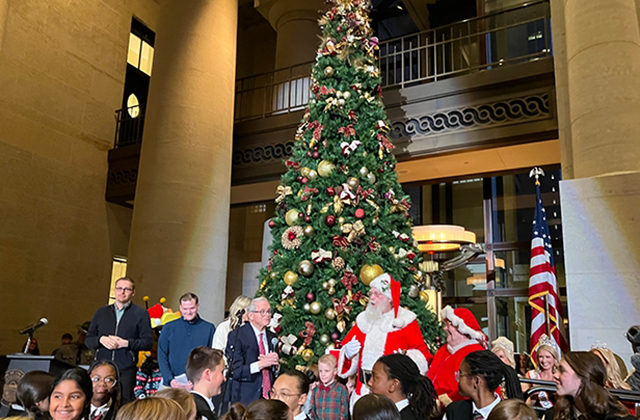 Holiday Festival and Tree Lighting 2025
Holiday Festival and Tree Lighting 2025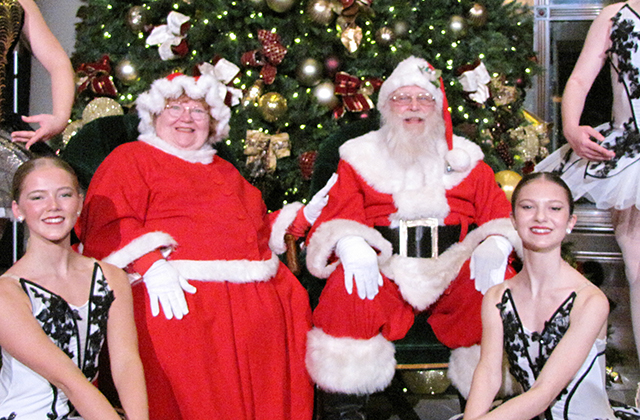 Holiday Santa Photos 2025
Holiday Santa Photos 2025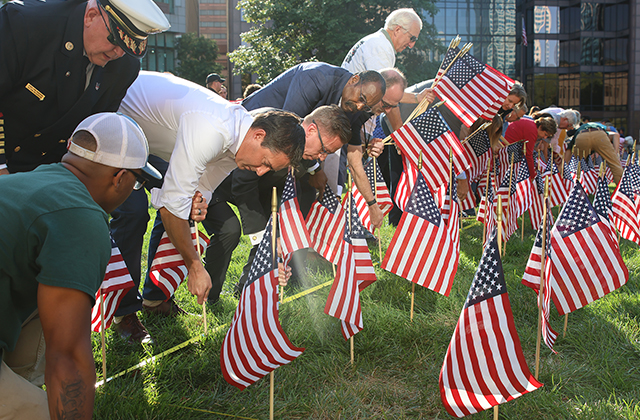 Flags for 9-11 in 2025
Flags for 9-11 in 2025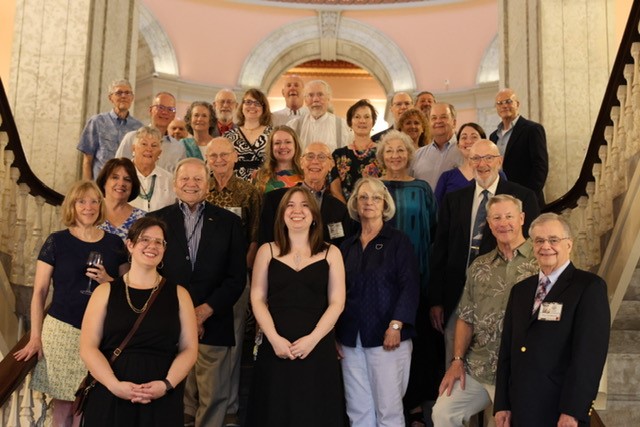 2025 Volunteer Appreciation Dinner
2025 Volunteer Appreciation Dinner America 250-Ohio
America 250-Ohio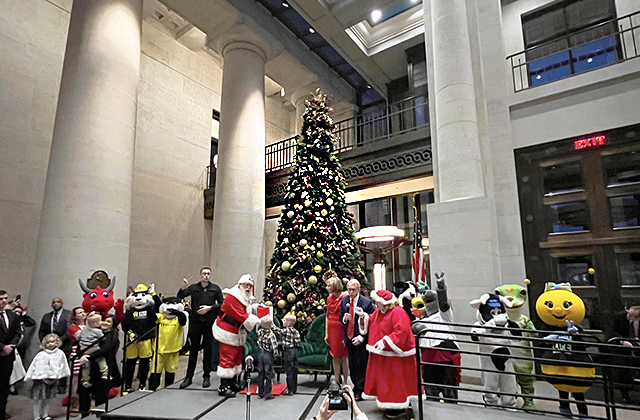 Holiday Festival and Tree Lighting 2024
Holiday Festival and Tree Lighting 2024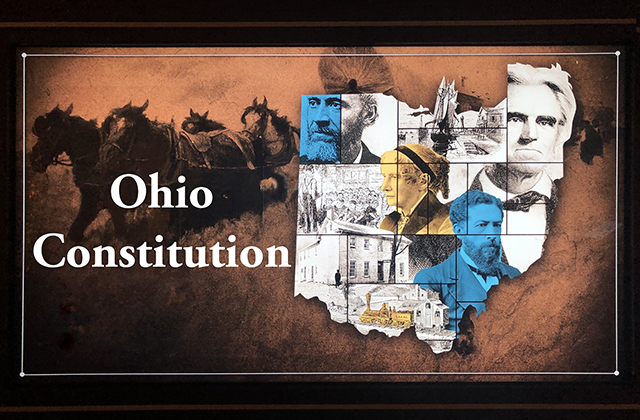 Ohio Constitution Videos
Ohio Constitution Videos Ohio Statehouse Videos
Ohio Statehouse Videos






